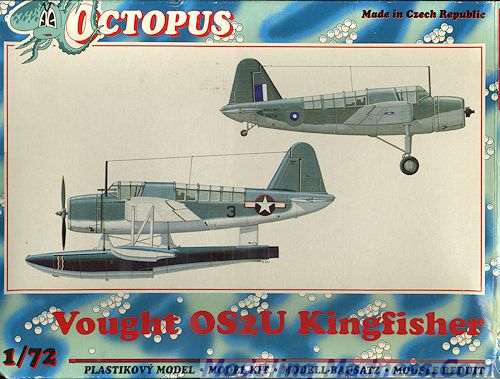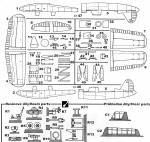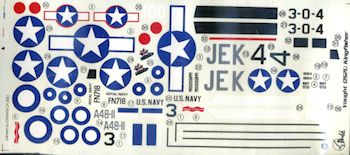
| KIT #: | 72025 |
| PRICE: | I paid $15.00 second hand |
| DECALS: | Five options |
| REVIEWER: | Scott Van Aken |
| NOTES: | Short run with resin and vacuformed parts. |

| HISTORY |
The Vought OS2U Kingfisher was an American catapult-launched observation floatplane. It was a compact mid-wing monoplane, with a large central float and small stabilizing floats. Performance was modest, because of its light engine. The OS2U could also operate on fixed, wheeled, taildragger landing gear.
The OS2U was the main shipboard observation aircraft used by the United States Navy during World War II, and 1,519 of the aircraft were built. It served on battleships and cruisers of the US Navy, with the United States Marine Corps in Marine Scouting Squadron THREE (VMS-3), with the United States Coast Guard at coastal air stations, at sea with the Fleet Air Arm of the Royal Navy, and with the Soviet Navy. The Royal Australian Air Force also operated a few Kingfishers from shore bases.
The Naval Aircraft Factory OS2N was the designation of the OS2U-3 aircraft built by the Naval Aircraft Factory in Philadelphia, Pennsylvania. The OS2U first flew on 1 March 1938. Post-war, several Central and South American nations flew the Kingfisher. The last military operator was Cuba, which retired the aircraft in 1959.
| THE KIT |
 This
kit dates from 2001 when Octopus/Pavla was producing quite a few kits. Nowadays,
they seem to have limited themselves to doing aftermarket resin sets instead of
full kits, which is a bit of a shame as they produced some very nice ones. Their
Kingfisher being a prime example.
This
kit dates from 2001 when Octopus/Pavla was producing quite a few kits. Nowadays,
they seem to have limited themselves to doing aftermarket resin sets instead of
full kits, which is a bit of a shame as they produced some very nice ones. Their
Kingfisher being a prime example.
If you are used to Czech short run kits from this time, you will recognize a common theme. Typical of a single engine prop kit, here is a single sprue of injected plastic, with very nicely done engraved panel lines, some large ejector stubs on the large parts, and a bit of rough edge flash. Resin is used for most of the interior bits that includes the seat, console panel, DF loop antenna, machine gun and the wheels among the more notable bits. Vacuformed plastic is used for the two canopy bits. These are nicely done with well defined frame lines.
The cockpit is very nicely done and the instructions would have you stretch sprue for the back of the instruments and add wire for the cables attaching to them. There is also a gun breech for the nose gun. In the back is a well done radio operator/gunner's position with a rather complex looking rear gun mount that attaches to the gunner's seat. The kit provides a channel for the control columns and one will need to stretch sprue in quite a few areas to build this assembly. The instructions provide all the information you will need to accomplish this.
One will ned to pay careful attention just prior to joining the fuselage halves as one will need to do a bit of cutting if doing the land based version. Tailplanes are a single mold while the wings are in upper and lower halves. The engine cowling is split vertically, which means there will be a forward lip that will undoubltedly need some work to smooth out. A very nice resin engine is provided along with a resin prop hub on which the two separate blades will need to be attached.
If doing the land based version, there is a nine piece fixed gear assembly that will need to be build up. For the floats bracing wire will need to be added on the main strut as will a crew handle for the main float and the back of the wing floats. Side bracing wires will also have to be added for the forward and rear float mounts. The mounting blocks for these will need to be scratch-built as well. The kit includes bomb racks, though no bombs as well as beaching gear for the main float.
 Instructions
are quite well done and provide many detail illustrations to help you position
all the bits and pieces. Color information is provided using a number of
sources. Markings are for five aircraft. Three of them are US Navy. One is a
pre-war 'yellow wings' version from VO-3 aboard the USS Mississippi with a true
blue tail. Next is a late 1942 training plane in blue-grey over light grey
that was based at Corpus Christi, Texas. The third is in a tri-color scheme that
was used to rescue downed pilots from Truk Lagoon in February 1944. For the
'foreigners', there is a blue-grey over light grey version on wheels that
operated from Ceylon in 1943/44. Finally, an Australian version in foliage
green/medium sea grey over light grey with 107 squadron near Sydney in mid 1942.
The decal sheet is very nicely done, providing wing walk markings and float
stripes. Though there are aftermarket sheets for this plane, what is provided in
the kit should satisfy most modelers.
Instructions
are quite well done and provide many detail illustrations to help you position
all the bits and pieces. Color information is provided using a number of
sources. Markings are for five aircraft. Three of them are US Navy. One is a
pre-war 'yellow wings' version from VO-3 aboard the USS Mississippi with a true
blue tail. Next is a late 1942 training plane in blue-grey over light grey
that was based at Corpus Christi, Texas. The third is in a tri-color scheme that
was used to rescue downed pilots from Truk Lagoon in February 1944. For the
'foreigners', there is a blue-grey over light grey version on wheels that
operated from Ceylon in 1943/44. Finally, an Australian version in foliage
green/medium sea grey over light grey with 107 squadron near Sydney in mid 1942.
The decal sheet is very nicely done, providing wing walk markings and float
stripes. Though there are aftermarket sheets for this plane, what is provided in
the kit should satisfy most modelers.
| CONCLUSIONS |
So there you have it. A very nice kit with a lot more detail than provided in the old Airfix offering. It will take quite a bit more work to build, but the end result will be a very nice model and well worth the effort. Due to the complexity of the kit, this one is only recommended to those who have experience with short run kits and who are not afraid to stretch some sprue.
| REFERENCES |
http://en.wikipedia.org/wiki/OS2U
July 2014
Thanks to me for the preview kit.
If you would like your product reviewed fairly and fairly quickly, please contact the editor or see other details in the Note to Contributors.